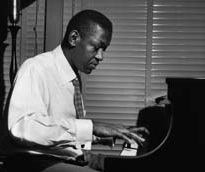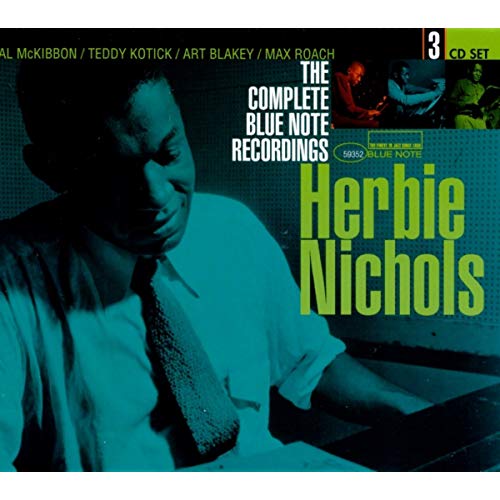Furthermore – Herbie Nichols
This playful song alternates F and A♭ tonalities. The melody includes several intervallic structures that are characteristic of Herbie Nichols. A 2-stave Piano Melody Transcription is available for the master take.
- Recording: Herbie Nichols - Complete Blue Note Recordings of Herbie Nichols
- Recorded on: August 7, 1955
- Label: Mosaic (MR5-118)
- Concert Key: F
- Vocal Range: , to
- Style: Swing (uptempo)
- Piano - Herbie Nichols
- Bass - Al McKibbon
- Drums - Max Roach
0:00
0:00
Buy MP3
- Description
- Historical Notes
- Solos
- Piano Corner
- Bass Corner
- Drum Corner
- Guitar Corner
- Inside & Beyond
- Minus You
First check out the rhythmic flow of the melody, how it drives to a syncopation and then to the beat, then adds space before starting a similar process (sing the rhythm of the A section). The B section is rhythmically contrasting, very downbeat oriented. To complete this 32-bar AABA gem, the rhythmic playfulness of the A section returns. Now check out the notes of the melody. Herbie melodically challenges your ear while the rhythm keeps propelling you forward.
Elijah Shiffer's concert key analysis below gives you an in depth look into the composition.
Analysis
Instantly recognizable as a Herbie Nichols composition, this song has that playful quality he excelled at. Within the A section, two keys are alternated: the opening four-measure motif in F is followed by a similar phrase, with a few important differences, in A♭. The stop-and-start rhythms give the melody a conversational quality, with a rest in the second measure separating a descending, slightly bluesy "call" from a more complex "response." This latter phrase is a characteristic Nichols structure, frequently appearing in his solos: an arpeggiated descent followed by rising half steps. These half steps appear in the fourth measure, but not in the eighth measure, where the melody stops on the 9th (B♭ in the key of A♭). The A section changes surround the tonic F and A♭ chords with the IV (B♭7 and D♭7, respectively); the tonic chords in between are in first inversion for smooth, stepwise root motion. The tonic chords then go to the ♭II (G♭7 and A7); in the second A section the A7 doesn't resolve to A♭7 but is held for two measures, with its third, C♯, in the melody.
The bridge is also quite unusual, with the changes moving in a circle of fourths from Bm7♭5, implying a "walk down" to F but instead continuing in minor seventh chords from Gm7; the second half of the bridge is a more conventional "walk down" with an added G♭ chord in the last measure. The bridge melody is simpler, but broken up by a convoluted 8th-note pattern in the second and sixth measures. Though the C section has the same changes as the first A, the last measure of the melody is different yet again, rising to G♭ (the seventh of A♭7).
The intro, also appearing as a coda, is a classic Nichols intro; it's a two-measure figure which uses the arpeggiated phrase from the third and fourth beats of the A section's seventh measure, which is repeated a whole step lower. In the intro this is followed by a four-measure drum break; the coda both precedes and follows the figure with four measures of drums. The solo drum break endings on many of the songs from these Blue Note sessions are one of the major idiosyncrasies of the Herbie Nichols sound.
It should be noted that Herbie's original manuscript contains a quite unusual rhythm in the first measure which he never actually plays. The fourth note in this measure, a C on the "and" of beat 2, is a 16th note, with the following G and A are 32nd notes. The G, E, and C after that are an 8th-note triplet on the third beat. This rhythm is very rushed at such a fast tempo, and on the recordings Herbie replaces it with a more relaxed rhythm where the final C ends up on the downbeat of the second measure, or sometimes on beat 2 of that measure. Our lead sheets show the most common rhythm he uses on the three takes, though he varies it considerably.
A Piano Melody Transcription is available for the in and out heads of the master take; click on Piano Corner for more details.
Elijah Shiffer's concert key analysis below gives you an in depth look into the composition.
Analysis
Instantly recognizable as a Herbie Nichols composition, this song has that playful quality he excelled at. Within the A section, two keys are alternated: the opening four-measure motif in F is followed by a similar phrase, with a few important differences, in A♭. The stop-and-start rhythms give the melody a conversational quality, with a rest in the second measure separating a descending, slightly bluesy "call" from a more complex "response." This latter phrase is a characteristic Nichols structure, frequently appearing in his solos: an arpeggiated descent followed by rising half steps. These half steps appear in the fourth measure, but not in the eighth measure, where the melody stops on the 9th (B♭ in the key of A♭). The A section changes surround the tonic F and A♭ chords with the IV (B♭7 and D♭7, respectively); the tonic chords in between are in first inversion for smooth, stepwise root motion. The tonic chords then go to the ♭II (G♭7 and A7); in the second A section the A7 doesn't resolve to A♭7 but is held for two measures, with its third, C♯, in the melody.
The bridge is also quite unusual, with the changes moving in a circle of fourths from Bm7♭5, implying a "walk down" to F but instead continuing in minor seventh chords from Gm7; the second half of the bridge is a more conventional "walk down" with an added G♭ chord in the last measure. The bridge melody is simpler, but broken up by a convoluted 8th-note pattern in the second and sixth measures. Though the C section has the same changes as the first A, the last measure of the melody is different yet again, rising to G♭ (the seventh of A♭7).
The intro, also appearing as a coda, is a classic Nichols intro; it's a two-measure figure which uses the arpeggiated phrase from the third and fourth beats of the A section's seventh measure, which is repeated a whole step lower. In the intro this is followed by a four-measure drum break; the coda both precedes and follows the figure with four measures of drums. The solo drum break endings on many of the songs from these Blue Note sessions are one of the major idiosyncrasies of the Herbie Nichols sound.
It should be noted that Herbie's original manuscript contains a quite unusual rhythm in the first measure which he never actually plays. The fourth note in this measure, a C on the "and" of beat 2, is a 16th note, with the following G and A are 32nd notes. The G, E, and C after that are an 8th-note triplet on the third beat. This rhythm is very rushed at such a fast tempo, and on the recordings Herbie replaces it with a more relaxed rhythm where the final C ends up on the downbeat of the second measure, or sometimes on beat 2 of that measure. Our lead sheets show the most common rhythm he uses on the three takes, though he varies it considerably.
A Piano Melody Transcription is available for the in and out heads of the master take; click on Piano Corner for more details.
This session from "The Complete Blue Note Recordings Of Herbie Nichols" was recorded at Rudy Van Gelder's legendary Hackensack Studio.
Three takes of Furthermore were recorded at the same session. After two uptempo takes at around quarter note = 268, Herbie recorded three other songs and then returned to Furthermore, recording a version at a much slower tempo (quarter note = 200). The second take is the master. The only other recording of Furthermore so far is on an album of Nichols songs, released in 2000, by the Boston-based guitarist Eric T. Johnson.
Three takes of Furthermore were recorded at the same session. After two uptempo takes at around quarter note = 268, Herbie recorded three other songs and then returned to Furthermore, recording a version at a much slower tempo (quarter note = 200). The second take is the master. The only other recording of Furthermore so far is on an album of Nichols songs, released in 2000, by the Boston-based guitarist Eric T. Johnson.
Our Piano Melody Transcription shows exactly what Herbie played on the in and out heads of the master take. Both times through the head, he varies the rhythms of the melody slightly; two notable examples on the in head are the first phrase, in which the triplet figure is delayed until the beginning of the second measure, and the last measure where the notes that are usually on beats 1 and 2 appear on 3 and 4. The rhythms of the left hand chords are very varied in the fifth through eighth measures of the A and C sections; some are anticipated and others delayed. Herbie plays the roots in the left hand on the bridge, voicing most of the longer melody notes in the right hand. The out head begins an octave higher, and then two octaves higher in the third through sixth measures. He doesn't play the second A section melody, improvising until the bridge. All notable accents and articulations are indicated for an in-depth look at Herbie Nichols' unique style.
Related Songs
Email Send Furthermore to a friend
Send this page to a friend via email. Add your name or email in the first field. In the second, add one or more email addresses, separated by a comma.

Herbie Nichols
January 3, 1919 – April 12, 1963
Don Sickler "On January 3, 2019, we were at the Van Gelder Recording Studio celebrating Herbie's 100th birthday with his family and pianists Frank Kimbrough and Glenn Zaleski. Both Frank and Glenn each recorded a previously unrecorded Herbie Nichols composition, on the same piano Herbie played for his Blue Note sessions. These were the initial recordings that started my new project, the Herbie Nichols Centennial Project, which debuts January 3, 2024. Read more...
There was a problem.
...



